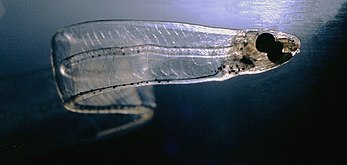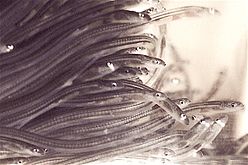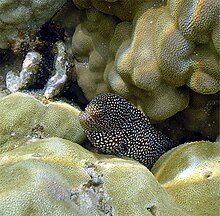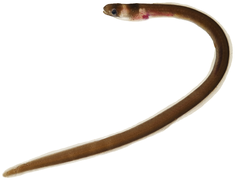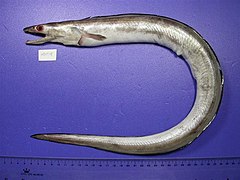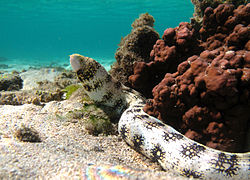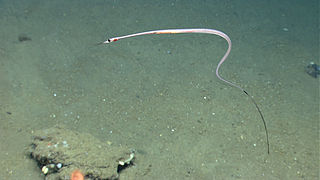
A | B | C | D | E | F | G | H | CH | I | J | K | L | M | N | O | P | Q | R | S | T | U | V | W | X | Y | Z | 0 | 1 | 2 | 3 | 4 | 5 | 6 | 7 | 8 | 9
| Eels Temporal range:
| |
|---|---|
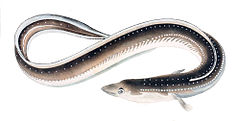
| |
| Anguilla japonica | |
| Scientific classification | |
| Domain: | Eukaryota |
| Kingdom: | Animalia |
| Phylum: | Chordata |
| Class: | Actinopterygii |
| Superorder: | Elopomorpha |
| Order: | Anguilliformes L. S. Berg, 1943 |
| Type genus | |
| Anguilla | |
| Suborders | |
Eels are ray-finned fish belonging to the order Anguilliformes (/æŋˈɡwɪlɪfɔːrmiːz/), which consists of eight suborders, 20 families, 164 genera, and about 1000 species.[3][4] Eels undergo considerable development from the early larval stage to the eventual adult stage and are usually predators.
The term "eel" is also used for some other eel-shaped fish, such as electric eels (genus Electrophorus), swamp eels (order Synbranchiformes), and deep-sea spiny eels (family Notacanthidae). However, these other clades, with the exception of deep-sea spiny eels, whose order Notacanthiformes is the sister clade to true eels, evolved their eel-like shapes independently from the true eels. As a main rule, most eels are marine. Exceptions are the catadromous genus Anguilla and the freshwater moray,[5] which spend most of their life in freshwater, the anadromous rice-paddy eel, which spawns in freshwater, and the freshwater snake eel Stictorhinus.[6]
Description

Eels are elongated fish, ranging in length from 5 cm (2 in) in the one-jawed eel (Monognathus ahlstromi) to 4 m (13 ft) in the slender giant moray.[7] Adults range in weight from 30 g (1 oz) to well over 25 kg (55 lb). They possess no pelvic fins, and many species also lack pectoral fins. The dorsal and anal fins are fused with the caudal fin, forming a single ribbon running along much of the length of the animal.[1] Eels swim by generating waves that travel the length of their bodies. They can swim backward by reversing the direction of the wave.[8]
Most eels live in the shallow waters of the ocean and burrow into sand, mud, or amongst rocks. Most eel species are nocturnal, and thus are rarely seen. Sometimes, they are seen living together in holes or "eel pits". Some eels also live in deeper water on the continental shelves and over the slopes deep as 4,000 m (13,000 ft). Only members of the Anguilla regularly inhabit fresh water, but they, too, return to the sea to breed.[9]
The heaviest true eel is the European conger. The maximum size of this species has been reported as reaching a length of 3 m (10 ft) and a weight of 110 kg (240 lb).[10] Other eels are longer, but do not weigh as much, such as the slender giant moray, which reaches 4 m (13 ft).[11]
Life cycle
Eels begin life as flat and transparent larvae, called leptocephali. Eel larvae drift in the sea's surface waters, feeding on marine snow, small particles that float in the water. Eel larvae then metamorphose into glass eels and become elvers before finally seeking out their juvenile and adult habitats.[7] Some individuals of anguillid elvers remains in brackish and marine areas close to coastlines,[12] but most of them enter freshwater where they travel upstream and are forced to climb up obstructions, such as weirs, dam walls, and natural waterfalls.

-
Eel eggs hatch firstly into the leptocephalus larval stage.
-
Larval eels become glass eels as they transition from the ocean to fresh water.
-
As freshwater elvers, eels work their way upstream.
-
Mature silver stage eels migrate back to the ocean to mate.
Lady Colin Campbell found that the eel fisheries at Ballisodare were greatly improved by the hanging of loosely plaited grass ladders over barriers, enabling elvers to ascend more easily.[13]
Classification
| This article is part of a series on |
| Commercial fish |
|---|
| Large pelagic |
| Forage |
| Demersal |
| Mixed |
Several sets of classifications of eels exist; some, such as FishBase which divide eels into 20 families, whereas other classification systems such as ITIS and Systema Naturae 2000 include additional eel families, which are noted below.
Genomic studies indicate that there is a monophyletic group that originated among the deep-sea eels.[14]
Taxonomy
The earliest fossil eels are known from the Late Cretaceous (Cenomanian) of Lebanon. These early eels retain primitive traits such as pelvic fins and thus do not appear to be closely related to any extant taxa. Body fossils of modern eels do not appear until the Eocene, although otoliths assignable to extant eel families and even some genera have been recovered from the Campanian and Maastrichtian, indicating some level of diversification among the extant groups prior to the Cretaceous-Paleogene extinction, which is also supported by phylogenetic divergence estimates. One of these otolith taxa, the mud-dwelling Pythonichthys arkansasensis, appears to have thrived in the aftermath of the K-Pg extinction, based on its abundance.[15][16][17]
Extant taxa
Taxonomy based on Nelson, Grande and Wilson 2016.[18]
- Suborder Protanguilloidei
- Family Protanguillidae
- Suborder Synaphobranchoidei
- Family Synaphobranchidae (cutthroat eels)
- Suborder Muraenoidei
- Family Heterenchelyidae (mud eels)
- Family Myrocongridae (thin eels)
- Family Muraenidae (moray eels)
- Suborder Chlopsoidei
- Family Chlopsidae (false morays)
- Suborder Congroidei
- Family Colocongridae (froghead eels, short tail eels)
- Family Congridae (congers)
- Subfamily Heterocongrinae (garden eels)
- Family Derichthyidae (longneck eels)
- Family Muraenesocidae (pike congers)
- Family Nettastomatidae (duckbill eels)
- Family Ophichthidae (snake eels)
- Suborder Moringuoidei
- Family Moringuidae (spaghetti eels)
- Suborder Saccopharyngoidei
- Family Eurypharyngidae (pelican eels, umbrellamouth gulpers)
- Family Saccopharyngidae
- Family Monognathidae (onejaw gulpers)
- Family Cyematidae (bobtail snipe eels)
- Suborder Anguilloidei
- Family Anguillidae (freshwater eels)
- Family Nemichthyidae (snipe eels)
- Family Serrivomeridae (sawtooth eels)
-
Serrivomer sp., a Serrivomeridae
In some classifications, the family Cyematidae of bobtail snipe eels is included in the Anguilliformes, but in the FishBase system that family is included in the order Saccopharyngiformes.
The electric eel of South America is not a true eel but is a South American knifefish more closely related to the carps and catfishes.
Phylogeny
Phylogeny based on Johnson et al. 2012.[19]

